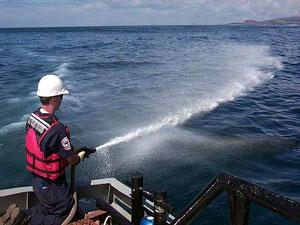Chemical companies stymie Gulf Coast scientists
Image by NOAA.
This story was originally covered by PRI’s Living on Earth. For more, listen to the audio above.
More than 1,284,000 gallons of chemical dispersants have been dumped on to the Gulf Coast in an effort to break up the oil spilling from the Deepwater Horizon disaster. Scientists are having a hard time figuring out the toxic effects of those chemicals, in part because the chemical companies that make the dispersants aren’t helping
Chemical companies are closely guarding the formulas for the chemical dispersants, even from scientists. The formulas are valuable trade secrets for companies like Nalco, makers of the dispersant COREXIT. Ron Kendall, who directs the Institute of Environmental and Human Health at Texas Tech University, told PRI’s Living on Earth that the company has prevented him from getting samples of the chemical. He said:
We need the COREXIT to learn the full potential impact of the oil in the Gulf. The oil is in many different forms, which we are investigating, and the dispersant affects the oil, it causes chemical changes. And, with those chemical changes there is a resulting differential and the potential toxicity to aquatic life. And so, that’s what we are getting after scientifically. That’s why this is so important.
At least three other scientists, including a marine sciences professor at the University of California Santa Barbara, have also been unable to get samples of the chemical. Living on Earth’s Jeff Young contacted Nalco spokesman Charlie Pajor, who said that any academic institution can contact them, and “we would be more than willing to work with them on trying to meet their requests.”
When pressed, Pajor admitted that he did not know if the company had fulfilled any requests for chemical samples, nor did he know if they had turned down any requests.
The problem isn’t limited to Nalco and COREXIT, either. Professor Samantha Joye of the University of Georgia has tried desperately to get samples of the dispersant for testing. She told PRI’s Living on Earth: “I and many others are still trying to get samples of the various dispersants that are being used. I’ve been unable to secure any so far.”
Back in the 1990s, there was a major push to understand what these chemicals were doing to the environment. But according to Dr. Nancy Kinner, director of the University of New Hampshire’s Coastal Response Research Center, that effort never succeeded. Congress never appropriate the promised funds, and “industry has also cut back on its R&D programs, so it really has been a problem across the board. And the comment always has been made that we don’t have big spills anymore.”
The current disaster in the Gulf Coast could be a more dangerous use of dispersants than in the past. In the Exxon Valdez crash, a known amount of oil was spilling into the water. In the Gulf Coast, cleanup crews are continuously spraying dispersant, potentially for a long time. Kinner told Living on Earth:
“I don’t think that our knowledge of dispersants is adequate. There’s just a lot of unknowns that still remain out there, and frankly the funding for this work has been very, very limited.”
Hosted by Steve Curwood, “Living on Earth” is an award-winning environmental news program that delves into the leading issues affecting the world we inhabit. More “Living on Earth.”
We want to hear your feedback so we can keep improving our website, theworld.org. Please fill out this quick survey and let us know your thoughts (your answers will be anonymous). Thanks for your time!
